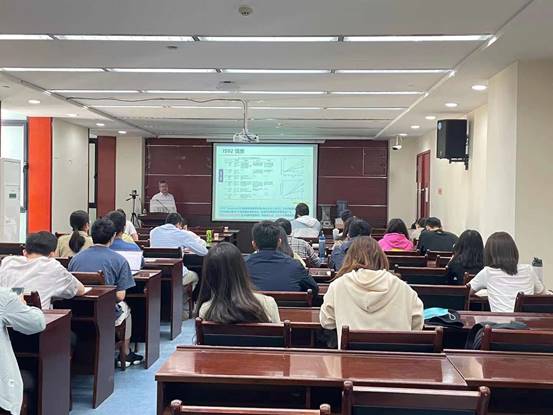On May 25, 2021, ProfessorJiang Tongof Nanjing University of Information Science & Technology, gave a lecture on "Introduction to climate change science" to our graduate students.
The theme of this course is "socio-economic development path and climate change scenario", which is mainly divided into five parts: 1. Proposal and evolution of climate change scenarios; 2. Emission scenarios of SA90, is92 and SREs; 3. The connotation and application of typical concentration pathways (RCPs); 4. Shared Socioeconomic Pathways (SSPs), including the choice of Socioeconomic development Pathways (SSPs), the setting and characteristics of Socioeconomic Pathways (SSPs), and RCPs / SSPs matrix; 5. Scenario application and SSPs prospect, including scenario application in various mode comparison plans, application in IPCC evaluation, application in regional and field research, as well as its weak links and future development. Professor Jiang Tong introduced that the climate scenario is a reasonable description of the temporal and spatial distribution of future climate state based on a series of scientific assumptions. In the study of climatology, scenario analysis is very necessary. For future climate change, different research institutions give different scenarios. In order to coordinate the research of climate scholars all over the world, IPCC proposed different climate scenarios, which are very helpful to predict future climate change.
Professor Jiang Tong said that climate scenarios can be used to predict economic development trends. Taking China as an example, GDP will increase by 1.6-5 times compared with 2016 under the scenarios of SSPs in the future. For SSP1 and SSP4, GDP first increases and then decreases slowly, reaching the peak in the 2080s and 2070s respectively; Under the paths of SSP2 and ssp5, GDP shows a trend of continuous increase, in which the growth rate under the path of SSP2 slows down after 2050, and the growth rate under the path of SSP5 has been maintaining a rapid growth; Under the SSP3 path, GDP increases first and remains almost unchanged after 2050. So climate scenario is a very practical tool.

At the end of the course, Professor Jiang Tong arranged several thinking questions for students and encouraged us to actively ask questions, be diligent in thinking and questioning, and strive to explore the vast scientific world. After class, the students gathered around the teacher and asked questions. The whole teaching atmosphere was active and the interaction between teachers and students was frequent. Students expressed that this course was rich in content and clear in order, and the teacher's narration was very helpful for students to understand the knowledge and benefited them a lot.
Jiang Tong, dean, professor and doctoral supervisor of the School of Geographical Sciences, Nanjing University of Information Science & Technology. He is a leading talent of meteorological science and technology of China Meteorological Administration. He is also a professor and doctoral supervisor of the University of Chinese Academy of Sciences. He has been engaged in climate change impact and risk research, disaster risk assessment and management for a long time. He is also the main author of IPCC AR5 WGII Ch3 (freshwater resources)and editor of IPCC AR6 Ch16(regional and industry key risks). He is currently Deputy Editor of international magazines such as Atmospheric Research and Climate Service. He has published more than 200 papers in Nature Communications, PNAS, BAMS, ESSD, etc.; He has written more than 20 monographs. He won the first prize of natural science of Xinjiang Autonomous Region, the second prize of progress prize in scientific of Hubei Province, the first prize of science and technology award of Changjiang Water Resources Commission of the Ministry Of Water Resources and the second prize of basic achievements of atmospheric science of Chinese Meteorological Society; He also won the second prize of progress prize in scientific in Jiangsu Province, first prize of Dayu water science and technology award of Ministry of Water Resources of the People’s Republic of China.